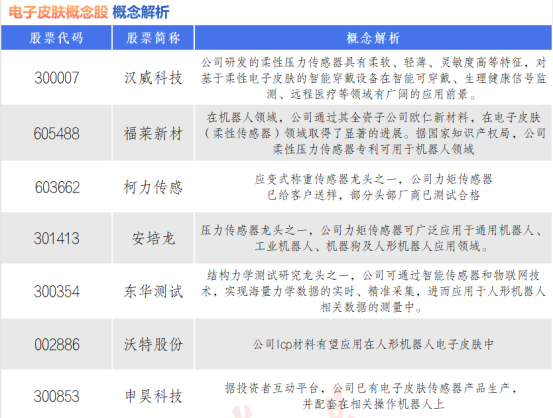Electronic Skin: The "Window of Interaction" for Humanoid Robots (with Concept Stocks)
![]() 02/06 2025
02/06 2025
![]() 602
602
Recently, the strategic positioning of major players in the humanoid robot industry has thrust the entire sector into the limelight of investors. Humanoid robots, with their intricate structures and myriad subdivisions, encompass a vast array of technologies. Today, we delve into one such crucial subdomain—electronic skin, the "window of interaction" between humanoid robots and the external world.
Electronic skin is a system that imbues robots with the ability to generate tactile sensations. Its design is straightforward yet versatile, capable of being molded into various shapes and adhering seamlessly to robotic surfaces, akin to clothing. This technology enables robots to discern the location, orientation, hardness, and other pertinent details of objects. Remarkably, humanoid robots equipped with electronic skin possess a superior sense of touch compared to humans. For instance, while a feather placed on one's hand might go unnoticed when eyes are closed, a robot with electronic skin can accurately detect its presence.
In contrast to cold metal, electronic skin is crafted from flexible materials such as polydimethylsiloxane (PDMS) and polyvinyl alcohol (PVA). These materials exhibit exceptional flexibility and elasticity, allowing them to adapt to the diverse movements and deformations of robots. Beyond pressure perception, electronic skin can also detect various physical parameters like temperature and humidity. For example, some electronic skin versions integrate temperature and humidity sensors, enabling robots to sense changes in their environmental conditions. This multifaceted sensing capability grants robots a more holistic understanding of their surroundings, facilitating more informed decision-making.
Moreover, the application of electronic skin extends beyond the realm of humanoid robots. In the medical field, its potential is equally promising. It can be integrated into intelligent prosthetics, enabling them to perceive external pressure and temperature, thereby providing more natural tactile feedback and enhancing patients' quality of life. Additionally, electronic skin can be utilized in health monitoring devices to continuously track vital physiological signals such as heart rate, pulse, blood pressure, and blood sugar levels, offering convenient and real-time monitoring solutions for healthcare providers.
According to a research report by Southwest Securities, electronic skin embodies physical flexibility and biomimetic properties. Currently, tactile sensors are predominantly applied to the hands of humanoid robots. However, as robots increasingly interact with humans, electronic skin's application may expand to cover the shoulders, elbows, and the front and back of the robot's body. It is estimated that the market potential for electronic skin corresponding to 1 million humanoid robots stands at approximately 10 billion yuan.
Data from the Common Industry Research Institute further indicates that the application scope of electronic skin will broaden from the hands to the limbs and ultimately encompass the entire robotic body, ushering in an era of universally intelligent robots. By 2030, the market size for electronic skin in humanoid robots is projected to reach 9.05 billion yuan, with a robust compound annual growth rate of 64.3%.
In summary, as an emerging flexible electronic device, electronic skin boasts high sensitivity, flexibility, multifaceted sensing capabilities, and self-healing properties, positioning it as a game-changer in fields such as humanoid robots, medical health, and space exploration.
Nonetheless, the development of electronic skin is not without challenges, including technological and material constraints, integration and manufacturing difficulties, performance stability issues, and commercialization hurdles. As technology continues to advance and costs decline, electronic skin is anticipated to achieve widespread adoption in the coming years, providing robust technical support for the evolution of humanoid robots and fueling innovation in robotic technology.
For investors' reference, the author has compiled a list of concept stocks related to electronic skin:

- End -





